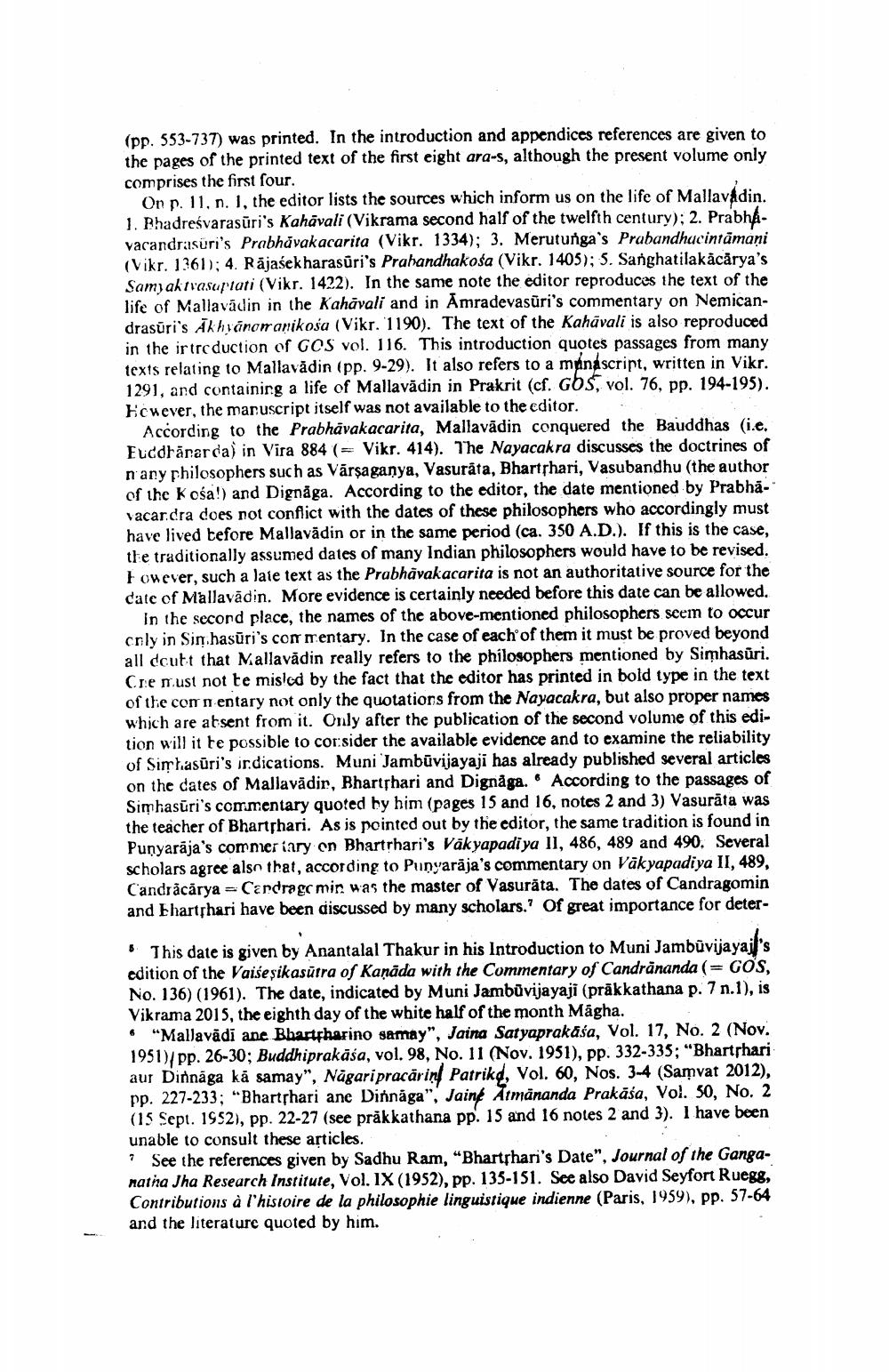Book Title: Nyayachakra Lekh Author(s): J W De Jong Publisher: J W De Jong View full book textPage 2
________________ (pp. 553-737) was printed. In the introduction and appendices references are given to the pages of the printed text of the first eight ara-s, although the present volume only comprises the first four. On n. 11. n. 1, the editor lists the sources which inform us on the life of Mallavadin. 1. Bhadreśvarasūri's Kahāvali (Vikrama second half of the twelfth century); 2. Prabhávacandrasuri's Prabhāvakacarita (Vikr. 1334); 3. Merutunga's Prabandhucintamani (Vikr. 1361); 4. Rajasekharasûri's Prabandhakosa (Vikr. 1405); 5. Sanghatilakācārya's Samy akivasuriati (Vikr. 1422). In the same note the editor reproduces the text of the life of Mallavādin in the Kahāvali and in Amradevasūri's commentary on Nemicandrasūri's ākhyānorranikosa (Vikr. 1190). The text of the Kahāvali is also reproduced in the introduction of GCS vol. 116. This introduction quotes passages from many texts relating to Mallavădin (pp. 9-29). It also refers to a manascript, written in Vikr. 1291, and containing a life of Mallavādin in Prakrit (cf. GOS, vol. 76. pp. 194-195). Ecwever, the manuscript itself was not available to the editor. According to the Prabhāvakacarita, Mallavādin conquered the Bauddhas (i.e. Fuddhānarda) in Vira 884 (= Vikr. 414). The Nayacakra discusses the doctrines of n'any philosophers such as Vārsaganya, Vasurāta, Bhartshari, Vasubandhu (the author of the Kośa!) and Dignāga. According to the editor, the date mentioned by Prabhā. vacar.dra does not conflict with the dates of these philosophers who accordingly must have lived before Mallavādin or in the same period (ca. 350 A.D.). If this is the case, the traditionally assumed dates of many Indian philosophers would have to be revised. However, such a late text as the Prabhāvakacarita is not an authoritative source for the date of Mallavādin. More evidence is certainly needed before this date can be allowed. In the second place, the names of the above-mentioned philosophers seem to occur crly in Sinhasūri's commentary. In the case of each of them it must be proved beyond all dcutt that Mallavădin really refers to the philosophers mentioned by Simhasūri. Cremust not te misled by the fact that the editor has printed in bold type in the text of the con n entary not only the quotations from the Nayacakra, but also proper names which are atsent from it. Only after the publication of the second volume of this edition will it te possible to corsider the available evidence and to examine the reliability of Simhasūri's ir.dications. Muni Jambūvijayaji has already published several articles on the dates of Mallavādir, Bharthari and Dignåga. According to the passages of Simhasūri's commentary quoted by him (pages 15 and 16, notes 2 and 3) Vasurăta was the teacher of Bhartshari. As is pointed out by the editor, the same tradition is found in Punyarāja's commer tary on Bhartrhari's Väkyapadi ya II, 486, 489 and 490. Several scholars agree also that, according to Punyarāja's commentary on Vākyapadiya II, 489, Candråcårya = Cardragc min was the master of Vasurăta. The dates of Candragomin and Ehartshari have been discussed by many scholars.? Of great importance for deter This date is given by Anantalal Thakur in his Introduction to Muni Jambūvijayajl's edition of the Vaiseșikasutra of Kanāda with the Commentary of Candrānanda (= GOS, No. 136) (1961). The date, indicated by Muni Jambūvijayaji (prākkathana p. 7 n.1), is Vikrama 2015, the eighth day of the white half of the month Magha. • "Mallavādi ane Bhartharino samay", Jaina Satyaprakaśa, Vol. 17, No. 2 (Nov. 1951)/pp. 26-30; Buddhiprakāśa, vol. 98, No.11 (Nov. 1951), pp. 332-335; "Bhartshari aur Dinnaga kā samay", Nāgari pracärin Patrikd, Vol. 60, Nos. 3-4 (Samvat 2012), pp. 227-233; "Bharthari ane Dinnaga", Jaink Atmananda Prakāśa, Vol. 50, No. 2 (15 Sept. 1952), pp. 22-27 (see pråkkathana pp. 15 and 16 notes 2 and 3). I have been unable to consult these articles. ? See the references given by Sadhu Ram, “Bharthari's Date", Journal of the Ganganatha Jha Research Institute, Vol. IX (1952), pp. 135-151. See also David Seyfort Ruege, Contributions à l'histoire de la philosophie linguistique indienne (Paris, 1959), pp. 57-64 and the literature quoted by him.Page Navigation
1 2 3 4 5 6
